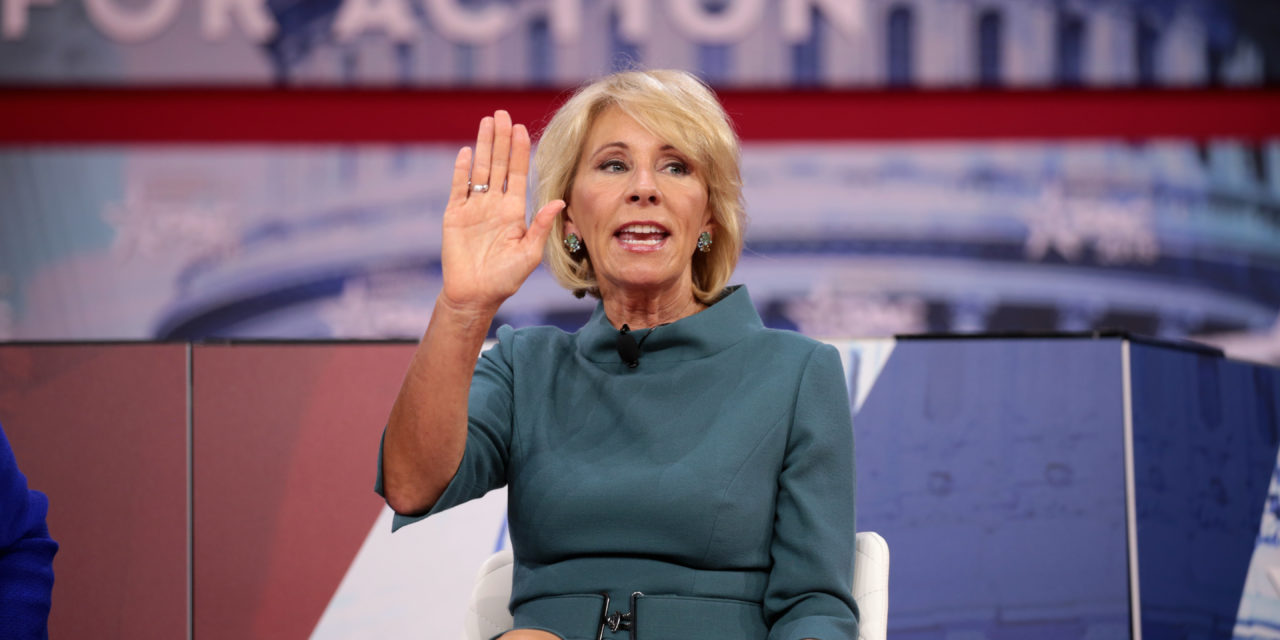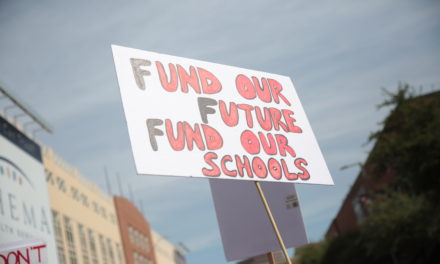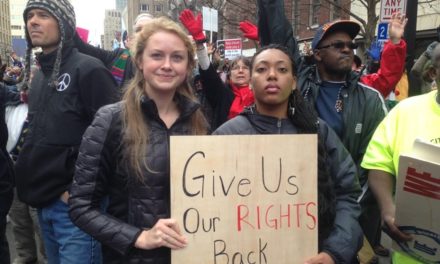When prominent advocates for “school choice,” such as U.S. Secretary of Education Betsy DeVos, talk about how a market-based approach for education works, the very stories they might cite as successes actually reveal serious shortcomings of charter schools and vouchers, especially about how they can have detrimental effects on parents, children, and communities. Take, for example, the case of Krystl Newton.
When the private Christian school Newton’s daughter attended closed, she was able to find a charter school near their home in Wake County, North Carolina, that provided a school culture similar to the private academy, with strict discipline, high academic standards, and none of the “gang stuff” (her words) she heard plagued the public schools.
Her daughter thrived in the new charter, so when Newton’s younger son reached kindergarten age, she was pleased the charter would enroll him under their family-members-first policy.
But after his kindergarten year, when he was ready to move to first grade, there was a problem.
Early in the boy’s development, Newton had observed symptoms of what she came to believe was a developmental disability resembling Tourette’s Syndrome. Although an official diagnosis of the disorder couldn’t be made until the child turned eight, Newton had already consulted specialists and gone to the trouble of developing an Individualized Education Program (IEP), a document that is developed for each public school child who needs special supports due to a physical, mental, or emotional disability. Because her daughter also had a mild form of disability when she enrolled in the charter, Newton assumed the charter would be fully accepting and supportive of her son’s situation too.
But the charter administrators felt otherwise.
“They wouldn’t accept our information,” she told me in a phone conversation, referring to her son’s IEP and other documents advising how to conduct his education program. Instead, the charter administrators said they would rely on their own “team” to develop a plan for her son and would “let you know” what the school would choose to support.
The plan the charter school ultimately came up with had few of the supports her son would need, Newton believed. Also, the school offered no recourse or way for her to appeal their decision. “They really had no intention of accommodating my son’s needs,” she said.
Fortunately, during the summer when her son was between kindergarten and first grade, Newton learned of a nearby public school that had the supports her son needed—including visits from an occupational therapist and access to instruction in a smaller class size. By the time I spoke with her, her son was attending a public middle school and “thriving,” she said. The special education staff had “partnered with our family,” she told me. “It was a terrific move.”
The feel-good story school choice advocates would make of this outcome is that Newton and her children benefited from having a community where there were lots of school options, and the fact they ultimately found a place for her son in a public school, while her daughter eventually graduated from the charter, is proof a market-based system in which parents have to essentially “shop” for schools to find the “best fit” for each child is what works best.
But Julie Mead has a problem with that.
Does ‘All Children’ Mean All?
“When public funds are tied to programs, there’s an expectation that the programs are then accessible to the entire community,” she told me in a phone interview. In Newton’s case, although the charter her children attended received public funds from the state and was subject to federal laws that ensure students with disabilities have free appropriate public education, the charter school was in fact not accessible to all public school children simply by the way it tailored its program to exclude students with more severe disabilities.
Mead, a University of Wisconsin professor, recently co-authored with Suzanne Eckes a policy brief for the National Education Policy Center warning that redirecting public funds to charter schools and voucher programs to pay for private school tuition subsidizes discrimination with taxpayer money.
The brief points to numerous research reports and news accounts finding that private schools participating in voucher programs often deny access to students and families on the basis of religious or sexual identity, learning ability, or fluency in English. Studies also show charter schools often enroll racially and economically homogeneous student populations and tend to have fewer students with special needs.
The authors contend that expanding more charters and voucher programs increases discrimination in schools because federal laws don’t hold public, private, and charter schools to the same standards, state legislatures too often ignore discrimination in creating charter and voucher programs, and privately operated schools have a free hand to design programs to discourage—or even prevent—undesirable students from enrolling.
Charters on Murky Legal Ground
The authors find discrimination is more likely in voucher programs than in charters, because private schools aren’t subject to the same laws as public schools. However, they point out that because of recent court decisions, charters inhabit a murky legal ground where their status as public or private entities is not settled.
In the case of Newton’s son, federal law requires that the charter provide necessary services for his education, no matter how costly and regardless of whether the school had ever offered the services before his enrollment.
But as the NEPC report explains, charter schools have programming authority that allows them to “exclude some populations.” Charters are free to gear their instructional services to specific ethnic or racial student populations. Or, as in Newton’s case, charter school officials can assure parents that their school has the necessary services to provide for a specific disability, and if the parents, as Newton did, opt for a school with existing expertise instead of the charter, then, “in such cases,” the brief explains, “the [charter] school official would not have discriminated, but the result—a school that serves fewer students with disabilities—occurs just the same.”
No doubt, the practices of charter schools will continue to be matters for litigation. However, few parents have the time or wherewithal to take these cases to court, charter authorizers and state officials who oversee these schools have few incentives to enforce stricter non-discrimination guidelines, and the charter industry shrugs off the problem.
But the real value in the NEPC brief is how it takes on the argument made by school choice cheerleaders that evidence of discrimination and exclusion in the privately operated education sector doesn’t matter.
Choice to Discriminate
The brief looks back at DeVos’ contentious budget hearing in the House earlier this year when Massachusetts Representative Katherine Clark asked her how a Department of Education under her leadership would respond to instances when schools receiving federal dollars were found to discriminate on the basis of race or sexual identity. In response, DeVos indicated her emphasis would be on states having “flexibility” and “parents making choices on behalf of their students.”
Since that hearing, DeVos has backtracked somewhat on allowing federal money to go to schools that discriminate against LGBT students, but on numerous occasions when she has been questioned about the problematic track record of school choice, her backstop argument has been that parental choice matters more than academic outcomes or social justice consequences, including increased inequality or discrimination.
Unfortunately, joining DeVos and school choice advocates in the Republican Party in their argument are a lot of Democrats. For instance, Peter Cunningham, communications director for former-U.S. Secretary of Education Arne Duncan, has suggested that fighting discrimination that causes racially segregated schools is “maybe … not worth it.”
In op-eds for prominent media outlets, Cunningham has declared that efforts to racially integrate schools have “hit a wall,” and because “ending poverty and integration are politically difficult and financially expensive goals,” the more important aim is to press for “needed reforms” in schools. At the very top of the “reforms” he advocates for are “the rights of parents and the best interests of children.” He declares, “No one can dispute the right of parents to choose their child’s school.”
While the primacy of parental choice might work well on a bumper sticker, Mead explains why this can create problems in a public education system that is supposed to serve the needs and interests of all students.
Understanding the Trade-Offs
“People need to understand what the trade-offs are between these choice options and parent and student rights,” Mead says.
Mead, who started her career as an educator of children who are deaf or hard-of-hearing, says the popular view of “choice” espoused by many—that parent choice has primacy over issues of equity—reminds her of what happened after the U.S. Supreme Court Brown v. Board ruling that outlawed racially segregated public schools. In retaliation to the ruling, many states in the South set up segregated academies for white students and justified the schools with arguments for parent choice.
Arguments for the primacy of parent choice today are far more sophisticated, with proponents saying that parents who opt into charter and voucher schools that are racially or ethnically homogeneous are choosing “culturally affirming” schools for their children. School choice proponents decry non-discrimination laws as “one-size-fits-all” impositions on privately operated schools. And rearguard defenders of the accountability movement from the presidential administrations of George W. Bush and Barack Obama contend that as long as student scores on standardized tests improve, the widespread segregation proliferating in the privately operated education sector doesn’t matter.
Representatives of the charter industry generally fight every effort to ensure their schools don’t discriminate. In North Carolina, where Newton lives, a charter school advocate who appeared at a prominent forum on charters said it was “not fair” for charter schools to have the same percentages and severity of special education students that local public schools have.
The hands-off message the charter industry leaders convey to lawmakers, many of whom receive substantial campaign donations from the industry, is that any regulations with the objective of “protecting students and taxpayers” are “harmful constraints” on their schools. And policies governing their schools should “focus on what a charter school is achieving, not how it does the work.”
These arguments come dangerously close, says Mead, to “transferring guarantees that we should have in society to provide all students with access to education to a permission-based system where we grant permissions to violate guaranteed access.”
She concedes, “It’s certainly difficult to create systems that are non-discriminatory. But if you get a system that departs from those guarantees of access and excludes large parts of the public, it’s no longer politically defensible.”
Her concern is, “As we shift into systems of choice, then we’ll shift accountability from the collective to the individual. So at some point, it leads to a situation where parents who’ve been wronged in the system are told, ‘If you’re not happy then it’s your fault; you should have chosen better.’”
Who Gets to Choose?
No doubt, our public education system has struggled at fulfilling the promise to guarantee an education for every student. But during the previous century, a progressive movement in the country gradually opened the schoolhouse door to students of low-income and working-class families, girls and women, and students of all races, religions, languages, and abilities.
Yes, there are still great inequities in the system. But why would we introduce new agents that likely make inequities worse?
“We need to find ways to ensure equitable access,” says Mead. “I’m not ready to give up that goal.”
What she and co-author Eckes recommend is for Congress to amend federal anti-discrimination laws to ensure state voucher programs operate in non-discriminatory ways and for federal agencies to consider withholding tax-exempt status and other benefits from schools that don’t meet non-discrimination standards.
At the state level, legislatures should include explicit anti-discrimination language in their voucher laws to ensure that private schools participating in publicly funded voucher programs do not discriminate against students and staff. And state lawmakers should adopt or amend charter school laws to ensure that throughout the life of a charter school (from proposal to renewal) there is a regulatory function that ensures every charter is attracting and retaining reasonably heterogeneous student populations.
As for Newton, her experience with school choice has persuaded her to urge parents with special needs children to “give public schools a chance.” About charter schools, she explains that while these schools advertise themselves as schools of choice, the reality is “as much as you choose it, the school chooses you.”
(Photo by Gage Skidmore, Flickr Creative Commons, CC BY-SA 2.0)






Recent Comments